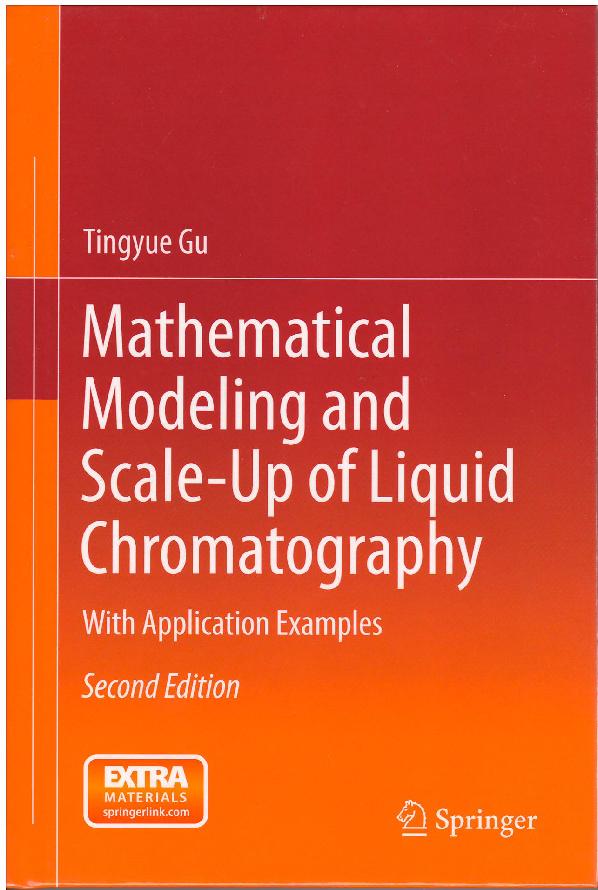Mathematical
Modeling and Scale-up of Liquid Chromatography

A monograph written by Tingyue Gu,
Dept. of Chemical & Biomolecular Engineering, Ohio University
Published by Springer Verlag, Berlin-New York, 2015.
(ISBN 978-3-319-16144-0, ISBN 978-3-319-16145-7 for ebook).
It has a total of 217 pages (vs. 123 pages in the 1st edition).
Original
(1st edition) book information and corrections are here.
2nd
edition book errata are here.
Preface
Liquid chromatography is no longer limited to chemical analysis. It has become an indispensable tool for the preparative- and large-scale purification of proteins and other fine chemicals including those from biorefineries. So far, the scale-up of liquid chromatography relies mostly on trial and error and a few scaling rules that are not precise enough.
This book provides numerical solutions to a series of general multicomponent rate models for liquid chromatography. The models consider dispersion in the main flow direction, interfacial film mass transfer between the bulk-fluid phase and the particle phase, intraparticle diffusion, and nonlinear multicomponent isotherms or the second-order kinetics. The models can be used to simulate various chromatographic operations such as breakthrough, elution (including gradient elution) and displacement. Various forms of liquid chromatography are covered, including adsorption, size exclusion, reversed phase, hydrophobic interaction, ion-exchange, and affinity chromatography. The models provide more realistic descriptions of preparative- and large-scale liquid chromatography than the equilibrium theory and plate models because various mass transfer mechanisms are included.
The first edition of this book was published in spring 1995 when personal computers were not powerful enough to run stiff cases very quickly. With the advances in computer hardware and software, the chromatography simulation software known as Chromulator described in this book can be easily run on today’s personal computers. The software with graphic user interface provides near-real time displays of simulated chromatograms. Comparisons using different input parameters are made effortlessly. In the past two decades, researchers have developed systematic methods to estimate the various parameters in the rate models, making the models much more useful in applications. A small chromatography column can be used in a lab setting to obtain parameters related to the packing structure and binding characteristics experimentally while mass transfer parameters can be estimated using existing correlations without any experiments. Assuming that a large column has the same packing structure as in the small column, a priori chromatogram predictions can be made through computer simulation before the large column is built or purchased.
Some academic instructors have adopted the simulation software in this work for teaching while others have used it for research and product development. Most readers do not need to be concerned with the complicated model equations and numerical methods when the primarily purposed is to use the chromatography simulator to study chromatographic behaviors or for prediction and scale-up. It is only essential to understand the binding characteristics (e.g., isotherms) and three basic mass transfer mechanisms such that parameter estimation work can be carried out. The application examples provided in this second edition contain sufficient details for the estimation of parameters needed to run the simulators. Two Microsoft Excel spreadsheet programs are provided for parameter estimation calculations. Sufficient details are given for almost all simulated chromatograms so users can reproduce using the Chromulator software.
Some parts of this book are based on the author's Ph.D. dissertation work at Purdue University, West Lafayette, Indiana, U.S.A. The author is deeply indebted to his dissertation advisor Prof. George T. Tsao for his guidance and encouragement. The author would like thank Drs. Xueliang Fang and Zhiguo Su of Institute for Processing Engineering, Chinese Academy of Sciences for coding the C++ graphical user interface. The newly added chapters and sections in this second edition dealing with the expansion of the rate models and application examples of the various models are mostly from research work conducted by the author, his graduate students and external collaborators. The author would especially like to thank Millipore researchers who collaborated with the author in the modeling of cored beads.
August 2014
Tingyue Gu